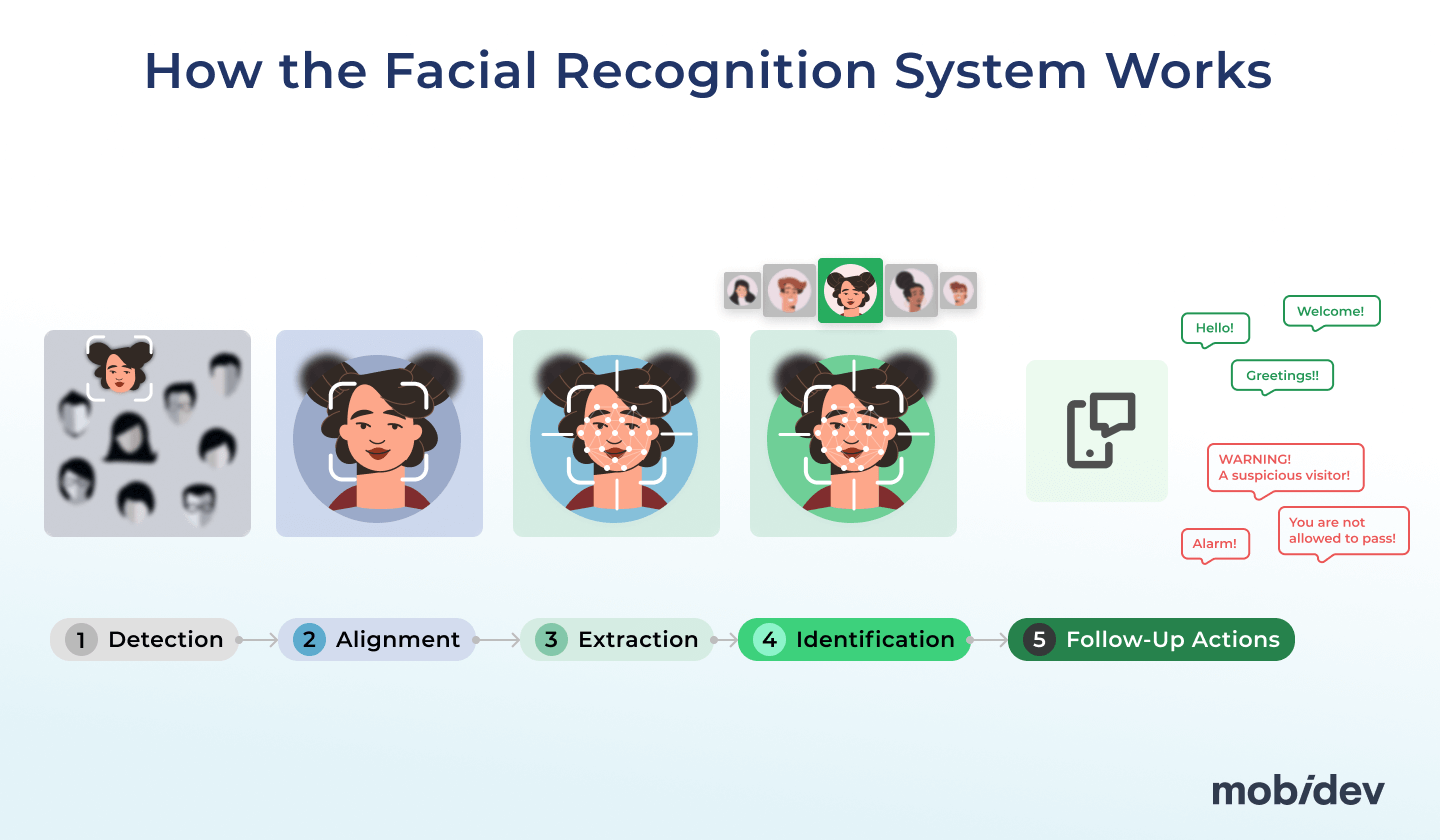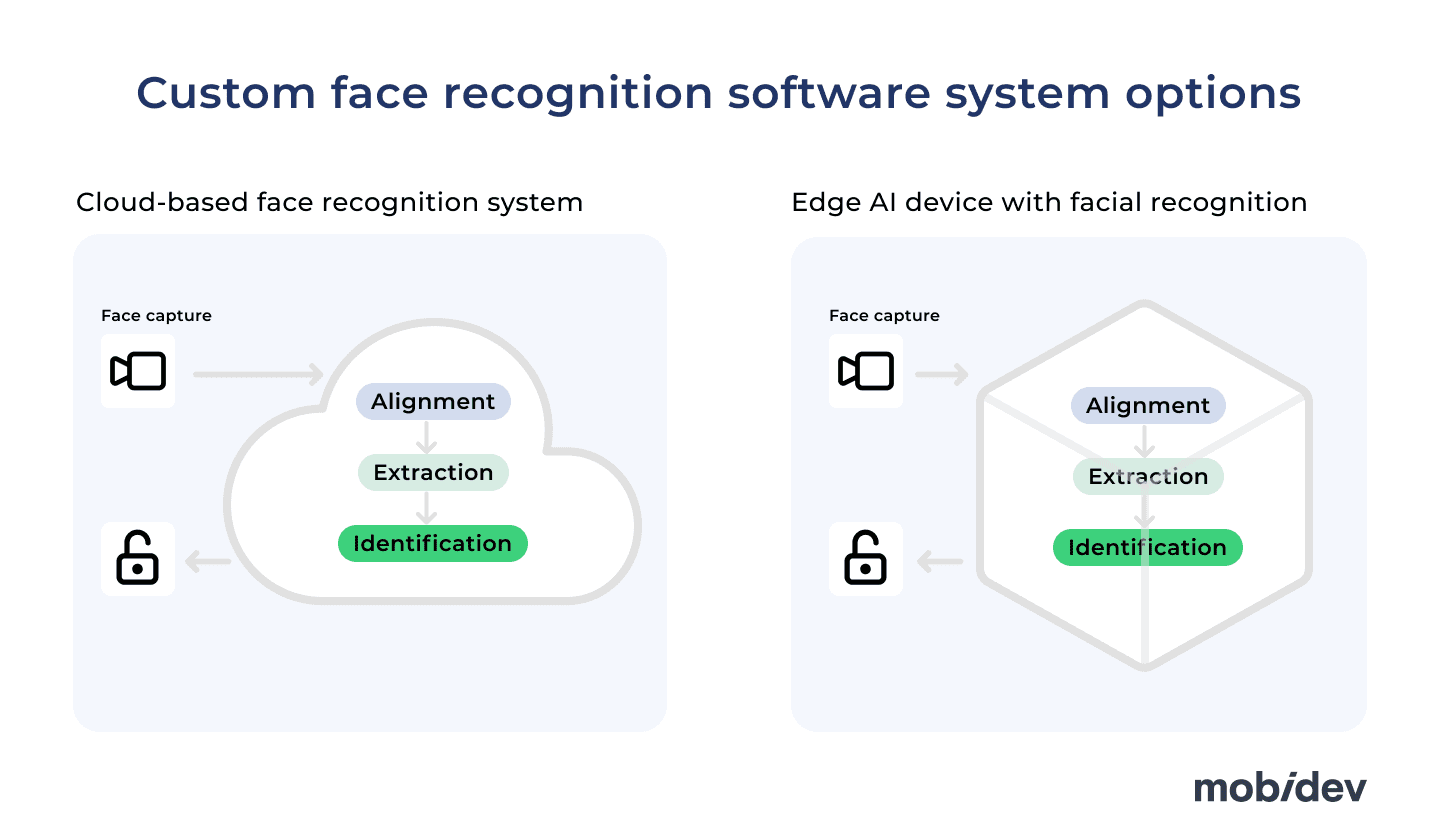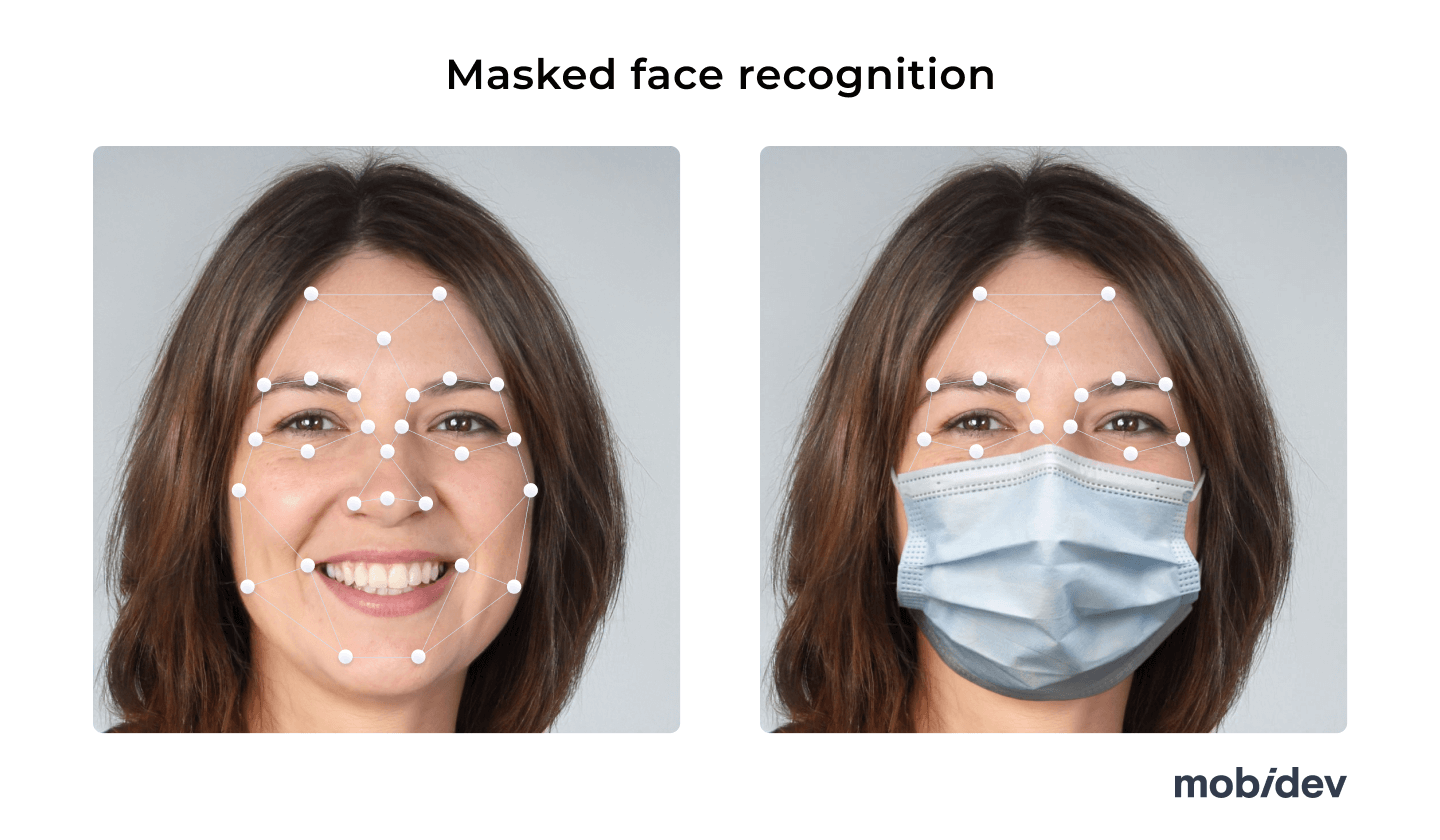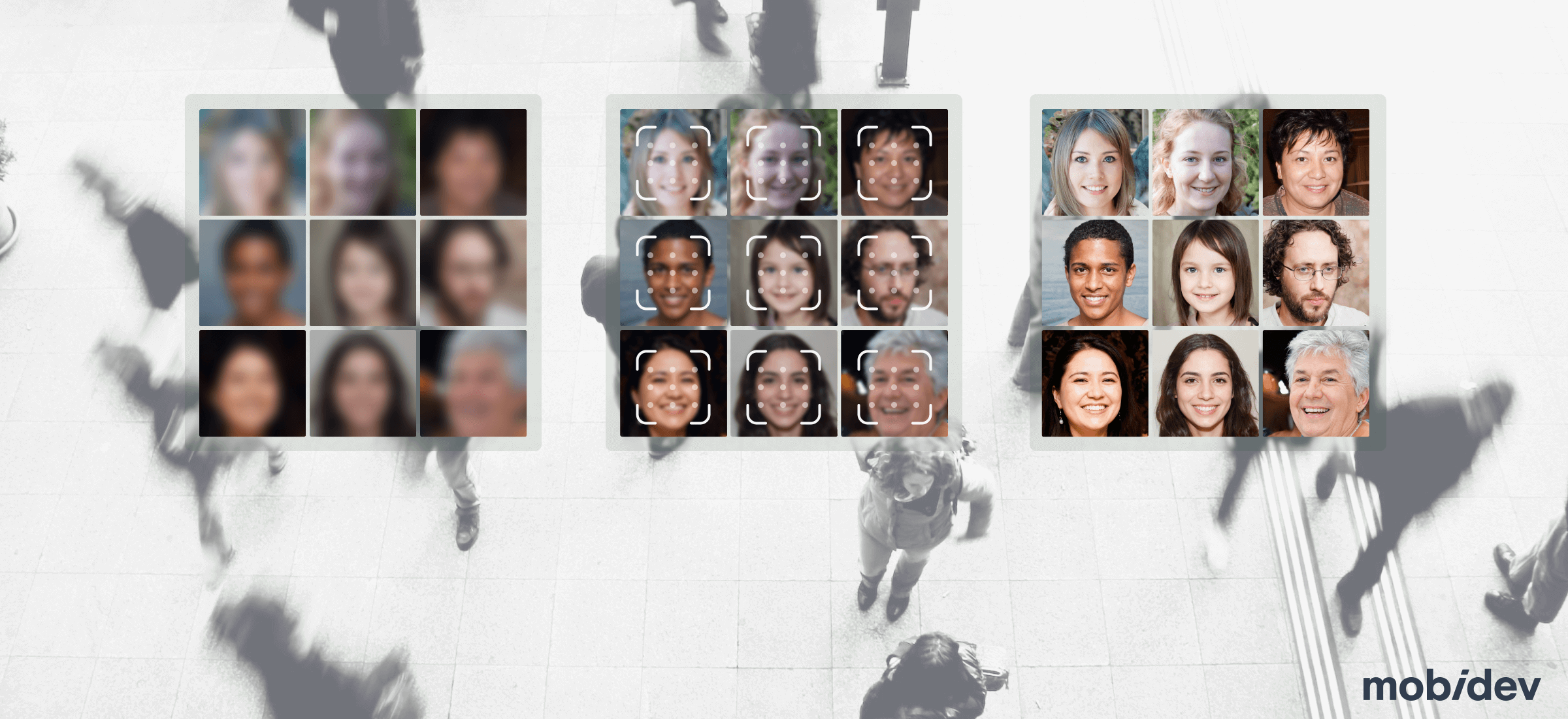Automated face recognition quickly moved from the category of interesting novelties to significant gamechanger in various industries. It has become a popular element for protecting digital devices, mobile and desktop applications, and websites.
Therefore, it is no coincidence that the demand for AI face recognition solutions is dynamically growing. The facial recognition market, which was approximately 5 billion USD in 2021, is estimated to reach 12.92 billion USD in 2027.
If you are looking for a way to integrate facial recognition into your app, this article will explain the sequence of steps needed to do so. We will consider in which cases ready-made solutions will suffice and when it is necessary to create custom face recognition software from scratch.
You will realize why custom AI face recognition offers such a significant contribution to security empowerment. Also, after getting acquainted with various business cases, you will be able to more precisely identify your need for custom face recognition software development services.
Human Face Identification: Evolution of Approaches
Scientists and inventors’ paths to automating face detection and recognition were neither easy nor quick. At first, there was no question of full automation. Some of the detection and recognition components were left to humans to perform. A face recognition system based on a manual recording of the coordinates of facial features was the first to be developed chronologically. Distances were calculated based on these coordinates. The computer was entrusted to perform the distance comparison for each image and calculate the difference between the distances.
Persisting scientific research on how to build a face recognition system, which will not require human participation, gradually began to bear fruit. In particular, it was possible to achieve computerized matching of faces by calculating the distances between facial features without the involvement of humans. The use of eigenfaces, i.e. sets of eigenvectors, for the mathematical expression of images became a significant impetus for the development of face recognition technologies. The analysis of the principal components of the image using eigenfaces became the basis of many algorithms.
For a long time, face recognition technology continued to arouse general interest, however, it did not yet demonstrate the accuracy expected from it. In particular, these technologies made more mistakes than there were when identifying people based on other biometric parameters – iris and fingerprints. At the same time, the significant advantages of automatic identification of people by their faces remained obvious. First of all, the system is non-contact, easy, and fast. That is why the necessity of attempts to build a face recognition system with an acceptable level of accuracy were required.
The effectiveness of technologies is evaluated from the point of view of how reliable facial recognition is under real-life circumstances. There are quite a few factors that complicate image analysis. It is enough to mention, in particular, fast and sharp movements, facial expressions, and insufficient lighting. It is not easy to achieve a system that copes with face recognition from different angles, with different head tilts. Deliberate attempts to change one’s appearance to avoid recognition are also common.
In this context, it is appropriate to formulate what the limitations of facial recognition are. Recognition accuracy is largely based on processing a large number of images. To achieve the correct result, it is appropriate to collect hundreds or even thousands of photos of the same person, but in different conditions. In particular, with different lighting (day/night, natural/artificial), from different angles, with make-up, with facial expressions, as well as with accessories or objects that can get into the frame (glasses, etc.).
The desire to use large volumes of image data for automated recognition led to the need for very powerful computing resources. In addition, in the task of face recognition, it is always necessary to take into account the operating time of the system.
An accurate but delayed identification is seldom useful. Thus, it must be stated that at some point it became impossible to overcome the limitations of face recognition within the limits of traditional approaches. Common automated recognition solutions were not accurate enough, and powerful and expensive systems could not be implemented en masse.
A breakthrough in creating advanced, fast, and affordable custom face recognition software solutions has come about thanks to recent advances in artificial intelligence (AI). Machine learning (ML), neural networks, and computer vision are areas of artificial intelligence where research is being done that is useful for facial recognition technology.
Deep learning (DL) is the part of ML that uses artificial neural networks. In the context of recognition tasks, convolutional neural networks (CNNs), which do not require too many computing resources to train and operate models, are particularly important. The improvement of DL methods occurs, including, through the use of an increasing number of layers of neurons that are in networks.
So, to date, the face recognition system based on deep learning is one of the most up-and-coming options for quick and accurate identification of a person. After finding out about the technological background, we will further consider how to make an app with facial recognition.
How to Build a Face Recognition System Step by Step
We will outline the five key elements to choose when starting to create a facial recognition app:
- Neural network architecture. Convolutional Neural Networks (CNNs) have proven themselves well for image classification and recognition tasks. Therefore, it is quite reasonable that we recommend using them. It is expedient to build a neural network for face recognition software on generally accepted architectural solutions, such as ResNet or EfficientNet. However, new architectures occasionally appear. Therefore, it is useful, before building a new system, to familiarize yourself with the current models. Fresh perspective will help you choose a better option.
- Hardware power. This is also a significant parameter. When developing face recognition software using deep neural networks, it is necessary not only to increase the accuracy of recognition but also to reduce the response time. This is why we think GPUs, for example, are better than CPUs for deep learning facial recognition systems.
- The database program to be used. The database will store information about users’ faces. We recommend using SQLite, as this database management system meets the necessary requirements for similar projects and needs minimal configuration effort compared to its counterparts.
- The application programming interface (API) for communication between the system components. It is necessary to decide whether to develop independently or to use existing APIs. Quite often, the simplest and fastest solution turns out to be completely sufficient.
- Inference time range. We determine which values of the inference time will be considered optimal. This is weighty when applying the developed neural networks in real-time.
The choice of components for face recognition app development requires finding a balance or even a trade-off between the accuracy of the solution and the speed of the system.
The core element of face recognition software is undoubtedly the deep learning model. Recently, more and more new opportunities are appearing in this direction.
In any case, the face recognition deep learning model contains algorithms for the main stages of the process. These stages are:
Face detection > Data alignment > Feature extraction >Face Identification
The system also provides automation of actions that should follow recognition. Algorithms for such actions are usually custom developed outside of the deep learning model.
The following face recognition deep learning methods are most used in practice:
- Work with pre-trained models. There are many pre-trained models on the market, which already have all the necessary algorithms. A custom face recognition software development company, to which you will entrust your project, will select the optimal version of such a ready-made solution. This method saves time and other resources. In addition, the correct setting of pre-trained models allows you to prevent bias and ensure the correct operation of the system. The training datasets for this type of model have thousands of images.
- Development of an artificial neural network from scratch. This approach makes it possible to develop complex advanced face recognition systems with full functionality, which may include unique features. However, such development is more time-consuming and expensive, as it requires the formation of a training data set from millions of images.
If you follow the second path, then the decision regarding loss function is essential. A loss function can be used to evaluate how well an algorithm models a data set. This is done by calculating the difference between the network’s predictions and the actual data.
The choice between the two methods is made based on the specifics and level of complexity of a particular problem, as well as the time available for its solution. At the same time, it should be noted that in the long term, a facial recognition system with unique functions is quite promising. In the end, below we will certainly consider in which cases it makes sense to use off-the-shelf solutions, and in which cases it is better to develop from scratch when you create a facial recognition app.
Face Recognition Software Workflow
So, let’s consider the sequence of operation of custom face recognition software. We will also briefly describe the main workflow stages.
1. Face detection
First, we need to detect that the static images or videos being studied contain exactly one or more faces. The model we use has a built-in algorithm for recognizing such objects as faces. We also set the format and parameters in which the captured image should be compared with the available data. Having found a face among the depicted objects, the face recognition software cuts it to the size of the frame we set. Next, the system sends the image to the server in a form convenient for comparison.
2. Data normalization / alignment
The fact is that the normalizing of images that we mentioned is not the only face-processing operation that may be required. The face can be taken from different angles or in poor lighting. However, the user expects the system to recognize faces under all conditions. Accordingly, the software must normalize or align the data to a form that will be compared to images from the database. Thanks to this, it is possible to reduce the influence of the factors mentioned above.
3. Feature extraction
We pre-install a set of the facial embeddings we mentioned above, which need to be identified and extracted from each recognized face. Most of the time, such sets consist of 128 unique features. Next, a neural network extracts such facial embeddings from face images.
4. Face Identification
In this step, the system algorithmically compares the unique facial features with the data available in the database using mathematical calculations. There is always the possibility of error. It is impossible to guarantee a 100 percent coincidence of the embeddings of the recognized face with the data of the database. Therefore, when we develop facial recognition software, we must set the embeddings’ matching level. Thus, a face will be considered recognized if the distance between the allegedly identical points on the compared images does not exceed the set level.
Face recognition software for different purposes requires different levels of precision. Customers of face recognition app development usually make this choice. As a rule, the highest facial features matching limits are set for systems involved in defense, security, finance, etc. In many other cases, when the price of a possible error is not so significant, more lenient requirements for the coincidence of facial embeddings are established.
We have already touched on the topic of what factors affect the accuracy of facial recognition. Increased interest in the question of the success rate of facial recognition is also quite natural. Undoubtedly, this subject deserves separate consideration. Another of our articles covers this issue in more detail, also detailing how you can improve the accuracy of face recognition.
5. Follow-up Actions: Alerting, Grant Access, and Other
One part of the software deals with the further actions of the system that depend on the recognition conclusion. Such an action may be a notification of a facial identification conclusion, which is forwarded to the user or the server, via a chatbot or other channel. According to the received message, further actions will be performed by other parts of the system or by a person, for example, an operator.

A common task of face recognition software is face verification to confirm the identity. The system must provide an unequivocal conclusion that the person who has been checked is exactly the person whose data is entered into the database. This identification is used in biometric authentication systems as a security tool for accessing applications, services, or databases. Accordingly, an example of a further action of the face recognition system is to grant access to a user whose identity is confirmed.
It should also be noted that modern face recognition software performs its tasks instantly, working in real-time. Such software can be used both autonomously and as an integrated part of some kind of system with wider functionality. For instance, these can be used for temperature screening at the entrance to a business or for multifactor identification of a person.
Follow the link of the case study below to see how we implemented face and voice recognition features into an enterprise verification-as-a-service solution for securing access to sensitive data.
Facial Recognition Feature Integration into Application
After we have considered the face recognition system design, we can touch on the format in which this feature will be offered to end users. This should be decided from the standpoint of not so much a technical perspective as through the use of business thinking. If face recognition has some self-sufficient value for you and your customers, bringing benefits, then this functionality can be implemented in a separate application.
A situation where you consider facial biometric identification as a step in a more complex process is possible. For example, you want to verify the user of your software in this way to provide him with a personalized offer or access to confidential information. In this case, you should enrich the existing application with a valuable feature. In this case, you will have to ask the custom face recognition software development company you cooperate with to ensure compatibility and integration with other elements of your current application.
Here, it is appropriate to return to the use of ready-made and custom-made solutions in face recognition system design. Let’s start with the fundamental element of the system – the deep learning model. We talked about the pre-trained models above. There is also always the option to develop your own custom model. However, you need to carefully evaluate your capabilities for this, as well as the feasibility of this step. How you implement a face recognition system may depend on this.
For the effectiveness of a face recognition system based on deep learning, it is not so much the development of algorithms or neural network parameters that is decisive, but the quality and relevance of training data. Thanks to a high-quality dataset, you can implement any algorithm and train a neural network well.
It is necessary to train the neural network on a dataset of images that will be as close as possible to those that the system will later recognize. Suppose that training takes place exclusively on photos of people from documents that were taken under ideal conditions. A neural network trained in this way will not cope very well with the recognition of images from video surveillance cameras installed in a subway station.
The amount of data to be collected plays a significant role. It depends on the purpose and place of application of custom face recognition software solutions. If the recognition will take place in rooms with constant good lighting, and if a person can be asked to stand straight in front of the camera for at least a moment, then the training data sample can be minimal. But when a custom face recognition development company creates a system that must work under difficult conditions, i. e. with low-quality video equipment, under different weather conditions, and with poor lighting, then a larger sample of image data will be required.
So, data is the main “raw material” for machine learning. And the main challenge when developing a model from scratch is access to the required amount of high-quality and relevant data. Some large corporations start collecting data long before they launch projects that will use it. Formation of datasets is time-consuming and expensive.
When trying to purchase the necessary data, in addition to the price, you should study the relevance and variability of the set as carefully as possible. Not all datasets perform equally well in different markets. So-called biased data is often offered, which does not take into account, for example, the color of people’s skin and facial features characteristics of representatives of various ethnic groups.
Accordingly, a high-quality and varied dataset should include as many images as possible of people of different races, genders, and age categories. Similarly, such a dataset should contain images taken under different lighting, at different times of the year, under different weather conditions, etc. A face recognition system based on correctly selected data will allow for fewer errors.
Therefore, it is advisable to start a new development project for a deep learning model for face recognition only if there is a dataset suitable for such a task. In particular, it is worth thinking about the development and training of new algorithms, having access to significant volumes of visual information, for example, data from large video surveillance systems for several years, etc.
If you do not have the necessary training data, then you can proceed to the consideration of pre-trained models. AI engineers who work on your project are able to choose a ready-made model with the necessary characteristics.
At the same time, as we said above, the part of the software that manages the actions of the system after recognition is beyond the pre-trained model and is the subject of custom face recognition development.
Continuing the theme of ready-made solutions, when you choose how to make an app with facial recognition, we will mention the APIs again. Since, in addition to the connection between the parts of the created system itself, interaction with other software is also important, software development kits (SDKs) will also be needed. The area studied in this article is dynamically filled with tools that greatly facilitate custom face recognition software solutions development.
Technology vendors do a lot to make it easier to implement face recognition systems. It can be said that even face recognition frameworks have appeared. We agree that it is logical, along with technologies, to offer APIs and SDKs for their integration into applications. There are also free-to-use libraries of computer vision software solutions.
Face recognition system and peripheral devices
When implementing a face recognition system, you should be ready to interact with many peripheral devices. Beyond a doubt, the deployment and integration of the system can be provided as one of the aspects of custom face recognition software development services, with the help of appropriate SDKs.
Along with that, it is expedient to keep in mind the possibility of using plug-and-play solutions. This approach consists of interaction with devices through one of the common standard automated interfaces such as USB, DVI, HDMI, SATA, etc. In such cases, there is no need for complex configuration of each of the devices and the development of additional integration solutions.
When creating a facial recognition app, you should imagine the conditions under which it will operate, and what the priorities of both you, as a customer, and future end users will be. This will help the contractor who will provide you with custom face recognition software development services to offer suitable technological approaches.
In particular, the choice between deploying the core elements of the system, i.e. models and data, in the cloud or using Edge AI is important. This affects the reliability, flexibility, and security of the software operation.
The face recognition system is based on the cloud – this is a common option that has many pros. But there are also substantial cons. Among them is the risk of data leakage during their transmission, and the dependence of the operation of devices integrated into the system on access to the Internet.
According to the Edge AI approach, custom face recognition software is installed and operated directly on devices. At the same time, devices can be portable, even wearable, and literally be at the user’s hand.

Of course, the technical requirements for such equipment and its cost are increasing. It cannot be otherwise, as the hardware power must be sufficient for fast operations. In addition, Edge devices must have their own GPU to quickly process incoming images. The internal memory, in turn, must contain all the necessary data.
But there are many advantages of such a face recognition system design. Reliability is much higher. First of all, this is the possibility of autonomous operation without an Internet connection and, for example, when equipped with a rechargeable battery, even without a power grid. The absence of the need for constant information exchange with the cloud via the Internet results in faster system operation and a higher degree of data protection.
The given example shows that the possibilities for creating a facial recognition app are constantly expanding and diversifying. AI development team will offer the latest technologies that best match the scope and specifics of the project.
After defining the tech stack and other aspects of development, the customer and the contractor will be able to more accurately estimate how much it costs to make facial recognition software. We have familiarized you with what choices you will have to make and what features to consider in the process of AI app development.
Use Cases of Face Recognition
The capabilities of AI face recognition that we described above are finding new applications in various spheres of life. The ability of face recognition software to provide an acceptable result in difficult conditions is especially in demand. The combination of face recognition with additional functions in one system also looks promising. Let’s turn to interesting examples.
Masked face detection and recognition
It is not always possible even for people to recognize a familiar person in a medical mask. However, thanks to deep learning algorithms and convolutional neural networks, automatic authentication systems can recognize faces with parts covered by masks with up to 95% accuracy. Face-eye-based multi-granularity algorithms and periocular recognition models are applied. As a result, the system correctly identifies a face only by mask-free features – forehead, face contour, ocular and periocular details, eyebrows, eyes, and cheekbones.

Identifying signs of the disease
Based on large volumes of medical images, a neural network trained by deep learning algorithms notices the signs of diseases in people.
Recognition of emotions
Facial expressions are no longer a “black box” for automated systems. In combination with face detection, this makes it possible to come to a person’s aid in time or make a targeted offer of goods or services.
Access systems to buildings and premises
We can all agree that allowing access to an office or residential building to a face-identified person is much more in line with the fast-paced modern life. Anyway, it can be much more efficient when compared to the requirement to carry and look for a key or card at the right moment.
Facial Recognition Software Development Services by MobiDev
We will be glad to continue the conversation about solutions based on AI facial recognition. Our experts deeply investigate the possibilities of facial recognition technology and research ways to overcome its current challenges and limitations. One of them is recognition accuracy. In the next article we are overviewing our approach to improving facial recognition systems’ accuracy with deep learning methods.
The demand for improving face recognition systems is constantly growing. For instance, another challenge is Presentation Attacks or PA. Unfortunately, spoofing, that is, the use of someone else’s image or its forgery, is no longer a rare phenomenon. It follows that anti-spoofing methods based on deep learning are now more relevant than ever. Trained convolutional neural networks detect distortions and inaccuracies sometimes even more precisely than human eyes. In this way, security is ensured when users perform everyday actions on the Internet.
At MobiDev, we`ll find the best approach to build and integrate a face recognition feature into your existing application. The expertise of our software engineers allows us to work with almost any tech stack you may need.
If you address us to develop the app from scratch, we can provide you with business analysis and product marketing consulting services. This capability will help you to create an outstanding product with user-centric UX to achieve your business goals.
Let’s talk about your project! We are eager to build something cool together!




